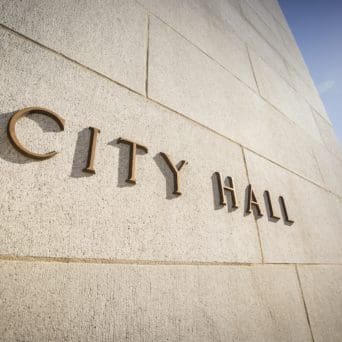2.0 Policy Package
Greenspace
Public greenspaces, from parks to trails to public commons, help families be healthier in body and mind and keep our environment thriving. Simply walking or sitting for about 15 minutes in a park can significantly improve daily mental health. Greenspace policies ensure all families, not just a few, have access to public land, nature, and their benefits.
The Greenspace Challenge
- Access to greenspace, including community schoolyards, public parks, walking trails, and other open spaces, is associated with improved mental health and sense of well-being among city residents.
- Other benefits associated with Greenspace include reduced violence, decreased mortality, lower heart rate, improved attention and mood, and a higher likelihood of physical activity.
- Neighborhoods that were historically subjected to redlining, the systematic practice of denying loans and other resources to people based on their race or ethnicity, tend to have significantly less tree cover and experience hotter temperatures than non-redlined neighborhoods.
A Healthy Solution: Greenspace
- Improves Mental Health — Parks help everyone have a healthier mind and body. When a Philadelphia project turned vacant lots into “pocket parks,” feelings of depression decreased among residents in those neighborhoods compared to residents in other neighborhoods.
- Helps the Environment Thrive — Tree coverage helps cool neighborhoods and reduce heat-related illnesses for residents — benefits that can extend as far as a half-mile from park boundaries.
- Cuts Pollution —Green infrastructure can reduce runoff and filter out up to 95% of storm water pollutants.
- Saves Lives — A $100 increase in county-level per capita investment in parks and recreation was associated with 3.4 fewer deaths per year per 100,000 people from 1980-2010.
CityHealth partners with the Trust for Public Land in support of this policy.
The state of Greenspace policies in big U.S. cities
54 out of 75 cities received a medal for greenspace policies, including 29 golds, 11 silver, and 14 bronze.
Measuring cities’ Greenspace policies
| How will we award greenspace medals? | |||
|---|---|---|---|
| The city council has adopted or ratified a policy or formalized planning goal either to a) achieve 100% park access within a 10-minute walk for all residents by 2040 or b) increase tree canopy coverage, with a specific measurable goal and time frame. | |||
| The city’s public spending on parks and greenspace is at or above the national median per capita, and the city maintains that level of spending within $10.* | |||
| Either the city’s 10-minute walk policy or its tree canopy goal clearly prioritizes underserved and disinvested neighborhoods, based on racial and/or economic equity, and/or data-driven park need. |
*The public funding data used for the Greenspace medals do not include programmatic investments. These measures are adjusted for local cost of living and inflation. These funding data are derived from the annual City Park Facts survey conducted by the Trust for Public Land.
Data Deep Dive
Data were created and maintained by the Center for Public Health Law Research.
Related Resources
Cities with Greenspace Laws
Legend
- Gold City
- Silver City
- Bronze City
- No Medal
- Coming Soon





